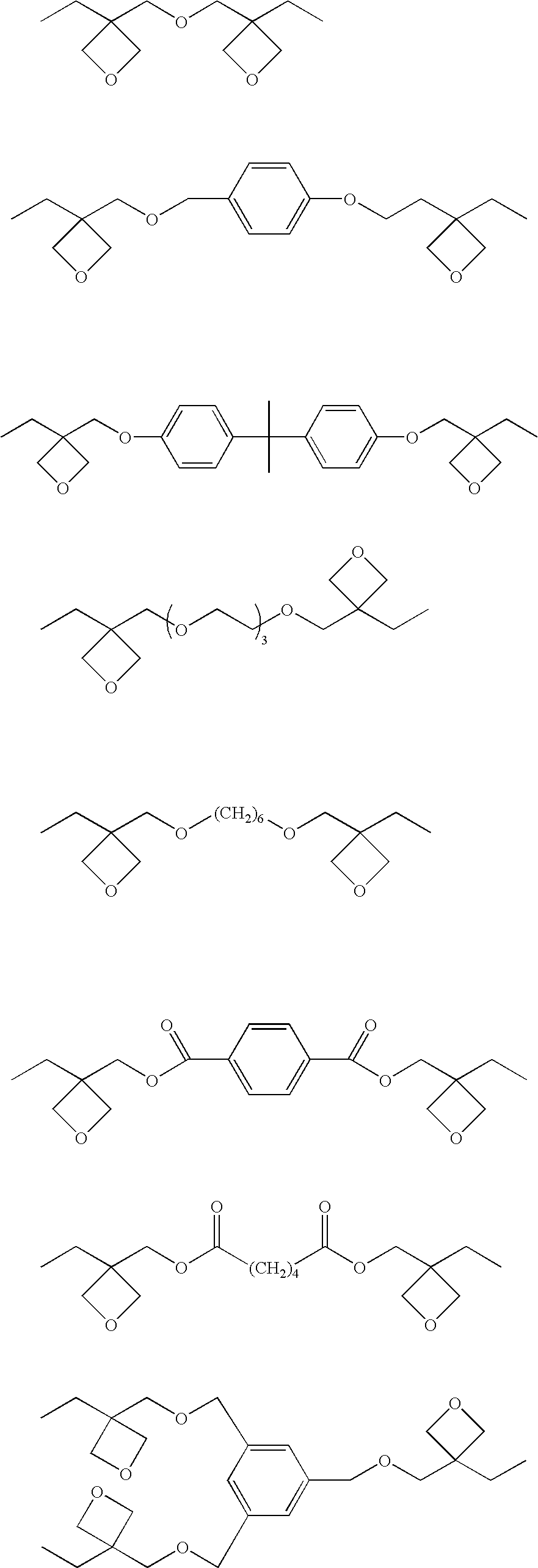Photopolymerization initiator and photopolymerizable composition
a technology of photopolymerizable composition and initiator, which is applied in the direction of photomechanical equipment, instruments, impression caps, etc., can solve the problems of large volumetric shrinkage of (meth)acrylate type radically polymerizable monomer, impaired polymerization of radically polymerizable monomer, and difficulty in obtaining aesthetic appearance to a sufficient degree, so as to improve the polymerization activity, and improve the effect of polymerization activity
- Summary
- Abstract
- Description
- Claims
- Application Information
AI Technical Summary
Benefits of technology
Problems solved by technology
Method used
Image
Examples
examples 1 to 37
[0155] To 100 parts by weight of the polymerizable monomers, there were added 0.2 parts by mass of photo acid-generating compounds, 0.05 parts by mass of photo radical-generating compounds and 0.05 parts by mass of fused polycyclic aromatic compounds as shown in Table 1 or 2, which were then dissolved in a dark place. The gelling times, curing properties and the cured depths of the solutions were as shown in Tables 1 and 2. In Examples 1 to 37, the cationically polymerizable monomers were used as the polymerizable monomers. In all Examples, the solutions were quickly gelled exhibiting favorable curing properties.
examples 37 to 40
[0156] To 100 parts by weight of the polymerizable monomers, there were added 0.2 parts by mass of photo acid-generating compounds, 0.05 parts by mass of photo radical-generating compounds and 0.05 parts by mass of fused polycyclic aromatic compounds as shown in Table 2, which were then dissolved in a dark place. The gelling times, curing properties and the cured depths of the solutions were as shown in Table 2. In Examples 38 to 41, Bis-GMA and 3G which were the radically polymerizable monomers were mixed to the cationically polymerizable monomers. In all-Examples 38 to 41, the solutions were quickly gelled exhibiting favorable curing properties. Besides, the gelling times were very shorter than those of Examples 1 to 37.
examples 42 to 52
[0170] The following solutions A to G were prepared.
[0171] Solution A:
[0172] To 100 parts by mass of a mixture of monomers of a weight ratio of OX-2 / EP-1=95 / 5, there were dissolved 0.8 parts by mass of DPISb, 0.1 part by mass of BAnQ and 0.1 part by mass of DMAn in a dark place to prepare a solution A.
[0173] Solution B:
[0174] By using a mixture of monomers of OX-2 / EP-2=95 / 5, there was prepared a solution B in the same manner as the solution A.
[0175] Solution C:
[0176] By using a mixture of monomers of OX-2 / DV=95 / 5, there was prepared a solution C in the same manner as the solution A.
[0177] Solution D:
[0178] By using a mixture of monomers of BOE / EP-2=50 / 50, there was prepared a solution D in the same manner as the solution A.
[0179] Solution E:
[0180] By using a mixture of monomers of OX-1:EP-2:Bis-GMA:3G=45.5:2.5:35:-15, there was prepared a solution E in the same manner as the solution A.
[0181] Solution F:
[0182] By using a mixture of monomers of OX-2:EP-2:Bis-GMA:3G=45.5:2.5:35:-15, t...
PUM
| Property | Measurement | Unit |
|---|---|---|
| absorption wavelength | aaaaa | aaaaa |
| particle size | aaaaa | aaaaa |
| refractive index | aaaaa | aaaaa |
Abstract
Description
Claims
Application Information
 Login to View More
Login to View More - Generate Ideas
- Intellectual Property
- Life Sciences
- Materials
- Tech Scout
- Unparalleled Data Quality
- Higher Quality Content
- 60% Fewer Hallucinations
Browse by: Latest US Patents, China's latest patents, Technical Efficacy Thesaurus, Application Domain, Technology Topic, Popular Technical Reports.
© 2025 PatSnap. All rights reserved.Legal|Privacy policy|Modern Slavery Act Transparency Statement|Sitemap|About US| Contact US: help@patsnap.com



